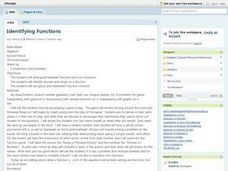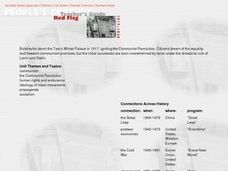Curated OER
Types of Government
In this types of government learning exercise, students write the advantages and disadvantages and countries that follow these governments. Students do this for 7 different types of government.
Curated OER
Bill of Rights: Rights and Responsibilities
Students explore the meaning of freedom. In this U.S. History lesson plan, students research the Declaration of Independence and how it relates to American freedom by completing activities and a mock trial.
Curated OER
My Country, My Country: To Vote or Not to Vote
Students view a film about elections in Iraq. They examine the story of a doctor and his decisions to vote. They work together to complete a worksheet about voter turnout.
Curated OER
Cartoons for the Classroom: The Bush and Clinton Years
Examine how the Bush and Clinton years are an example of political dynasties. This cartoon provides a way to explore the concept and activate critical thinking skills in order to better grasp U.S. Politics. A fun and educational way to...
EngageNY
Polynomial, Rational, and Radical Relationships
This assessment pair goes way beyond simple graphing, factoring and solving polynomial equations, really forcing learners to investigate the math ideas behind the calculations. Short and to-the-point questions build on one another,...
Curated OER
Bill of Rights: Rights and Responsibilities
Students explore the Bill of Rights. In this U.S. Constitution lesson, students consider the individual liberties outlined in the Bill of Rights as they read the provided handouts and complete the provided worksheet activities.
Curated OER
Identifying Functions
Students, after completing a warm up exercise on one proportion word problem, distinguish between functions and non-functions. They identify domain and range on a function as well as recognize and implement function notation. They solve...
Curated OER
Communist Revolution
Students examine the Russian Communist Revolution of 1917. They watch and discuss a video, take notes and answer video discussion questions, and read and evaluate newspaper articles about how Lenin and Stalin are viewed today in the...
Curated OER
Cartoons for the Classroom: The Bush-Clinton Years
In this current events worksheet, students analyze a political cartoon about political dynasties and respond to 3 talking point questions.
Curated OER
Real Number System
Ninth graders discuss the real number system and its' properties. In this algebra lesson, 9th graders discuss rational, irrational, closure, real numbers and the distributive property of algebra. They solve problems using these...
Curated OER
Dragons Of China And Japan
Students create drawings of dragons that could be found in the art of Japan or China. The lesson involves two-days of instruction and leads to student examples of dragons four-times larger than the originals.
Curated OER
Yin And Yang
Students examine the symbols of change, Heaven and Earth, as expressed in
Chinese art and literature in this High School lesson. Evaluation is accomplished through a short, small-group research project.
Curated OER
Comparison of King Lear and King James
Students learn of the comparisons between Shakespeare's play, King Lear, and the actual King James. They make historical connections through internet research.
Curated OER
Living Tobacco Free
First graders explore how smoking and tobacco are made of harmful substances.
Curated OER
Chapter 8: Deviance and Social Control
In this deviance and social control worksheet, students respond to 14 fill in the blank questions and 15 matching questions pertaining to crime and how societies attempt to control it.
















